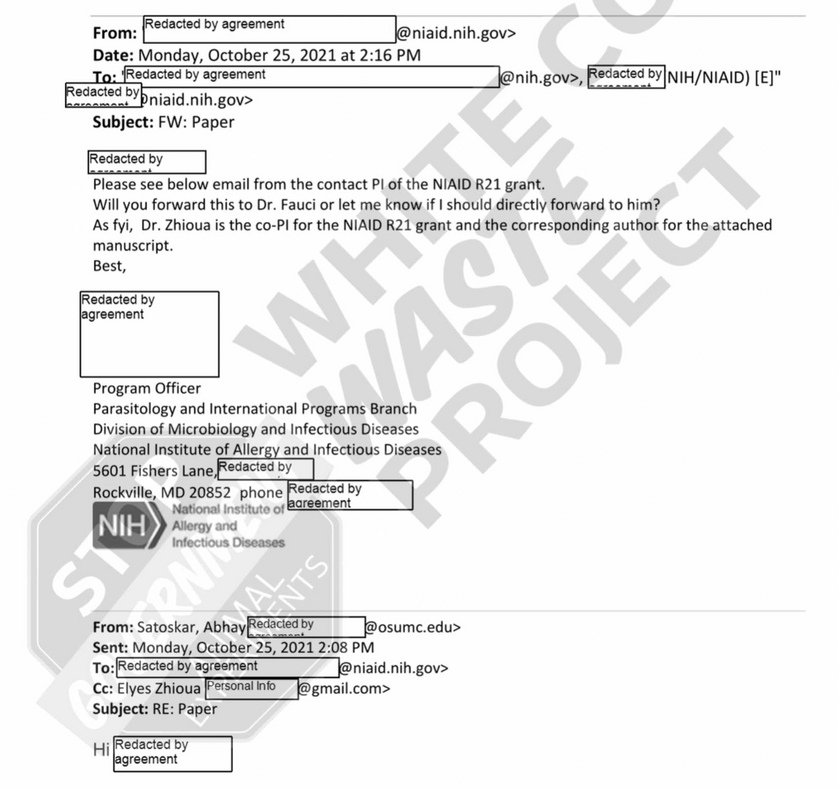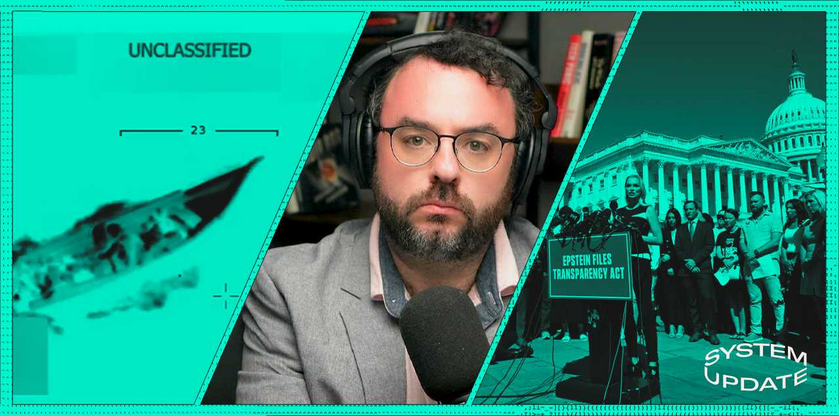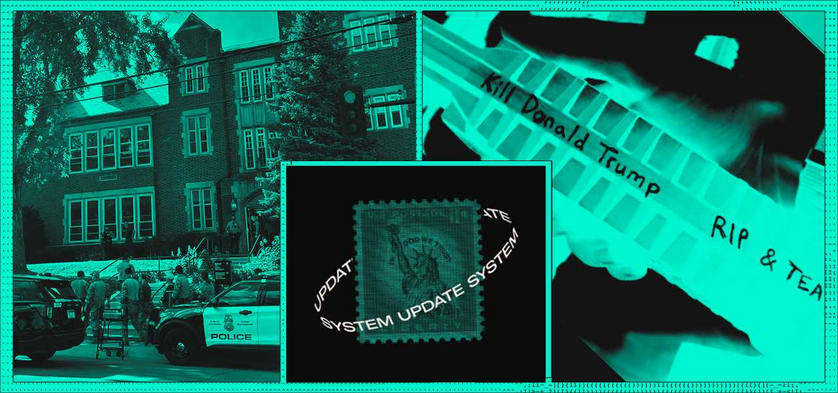On the morning of October 25, 2021, Dr. Anthony Fauci dashed off an email to eight of his colleagues, asking them to look into an experiment conducted in Tunisia in 2019. It was urgent. “I want this done right away,” he wrote, “since we are getting bombarded by protests.”
The experiment Fauci was referring to was the one that Representative Marjorie Taylor Greene asked him about this week in a heated Congressional hearing. Holding up a photograph on poster board of two beagles with their heads locked into mesh cages, she said, “As director of the NIH, you did sign off on these so-called ‘scientific experiments,’ and as a dog lover, I want to tell you this is disgusting, and evil.”
Greene is to liberals what Alexandria Ocasio Cortez is to conservatives: an easy target for partisans to mock. Her questioning of Fauci predictably inspired the usual derision. MSNBC’s Lawrence O’Donnell, referring to Greene as “the consistent frontrunner for stupidest member of the House of Representatives in history,” sneered, “No one knew what she was talking about.”
But in fact, Fauci knew exactly what Greene was talking about. Three years ago, the experiment in question was at the center of an entire crisis communications response within NIAID (the institute within NIH run by Dr. Fauci). Fauci claimed that it had provoked so many angry calls that his assistant had to stop answering the phone for two weeks. The day before Fauci sent his email about being “bombarded by protests,” one of his colleagues had advised him, “It might be wise to hold off on TV until we have a handle on this.” The story had become a full-blown publicity crisis for Fauci and NIAID — until the Washington Post came to his rescue, turning a legitimate news story into “right-wing disinformation,” based on flimsy evidence that was literally concocted by Fauci’s team.
In 2019, under the auspices of a microbiologist at the University of Ohio, researchers in Tunisia placed the heads of sedated beagles in mesh bags filled with starved sand flies. This was the image Rep. Greene had held up at this week’s hearing. Later, the beagles were placed in outdoor cages for nine consecutive nights, in an area dense with sand flies infected with a parasite that carries the disease with which the researchers were trying to infect the dogs.
In his paper, the Ohio microbiologist, Abhay Satoskar, along with his research partner, acknowledged funding from NIAID, which added up to about $80,000, alongside the grant number. The grant application read:
“Dogs will be exposed to sand fly bites each night throughout the sand fly season to ensure transmission…Dogs will be anesthetized…and for 2 hours will be placed in a cage containing between 15 and 30 females…”
The description fits the experiments in Tunisia perfectly.
In August of 2021, White Coat Waste Project, a non-profit group that advocates against federal funding of animal experimentation, exposed NIAID’s support for the experiment in a blog post. In October, based on White Coat Waste’s revelations, a bipartisan group of Congressional representatives released a letter expressing concern about cruel NIAID-funded experiments on dogs, drawing particular attention to the fact that some of the dogs had had their vocal cords severed to keep them from barking and howling in pain and distress. The story generated a maelstrom online, leading to the angry phone calls Fauci claimed to have received. “#ArrestFauci” trended on Twitter.
NIAID staff went into damage control mode. Within hours of Fauci asking his staff to look into the experiment, Satoskar emailed NIAID, following up on a phone call. Satoskar now claimed that the acknowledgment of NIH funding was a mistake. “This grant was mistakenly cited as a funding source in the paper,” he wrote.
Later, NIAID would claim that it only funded an experiment that involved vaccinating the dogs against Leishmaniasis, the disease carried by the parasites in the sand flies. Leishmaniasis is the disease with which Satoskar infected his subject beagles in Tunisia.
There is no way to know what was said on the phone call with Satoskar, but released emails show that this is exactly what NIAID wanted to hear. “Will you forward this to Dr. Fauci or let me know if I should directly forward to him?”, the recipient of the email at NIAID wrote to a colleague (the names in the emails, which were obtained by a FOIA request from White Coat Waste Project, are redacted).


Satoskar then hurried to delink the paper from NIAID funding. Less than ten minutes after sending his email to NIAID, Satoskar emailed Shaden Kamhawi, editor of PLOS Neglected Tropical Diseases, the journal that had published the paper on the experiment. “We would like to request correction of this error,” Satoskar wrote.
He might as well have been asking himself. Kamhawi is a colleague of Satoskar. She is an expert on precisely the subject that Satoskar was studying. “Dr. Kamhawi is a world expert on phlebotomine sand flies,” her curriculum vitae reads, “vectors of the neglected tropical disease leishmaniasis.” Like Satoskar, Kamhawi has conducted research in which she used sand flies to infect beagles with the disease. She has even co-published with him. Indeed, Kamhawi’s own research has been the subject of White Coat Waste Project exposé. On top of that, she is an employee of NIAID: meaning that Anthony Fauci is her boss.
Kamhawi was aware of at least the last of these potential conflicts of interest. “BTW,” she emailed her colleagues at PLOS NTD, “as I am an NIAID employee, “I am not sure if there is a COI [Conflict of Interest] here so please let me know.”
It’s unclear whether the journal took that conflict seriously. In any case, the correction went forward. The journal now read:
“There are errors in the Funding statement. The correct Funding statement is as follows: the authors received no specific funding for this work. The US National Institutes of Health and the Wellcome Trust did not provide any funding for this research and any such claim was made in error.”
This was the exonerating evidence that went out to reporters. On October 27th, a NIAID employee wrote to colleagues that “we can at least share with reporters that the journal has made the correction.” Another NIAID staffer emailed colleagues for help fielding a query from an Associated Press “fact checker,” who asked how NIAID could be sure that their funds weren’t used for the Tunisian beagle experiment. “Our evidence is simply the statement of the PI [Principal Investigator], Dr. Satoskar,” came the reply.
In fact, NIAID had no way to be certain that its funds were not used on the Tunisia experiment. Michael Fenton, Director of NIAID’s Division of Extramural Activities, wrote in an email, “It seems to me that the only way to prove that the grant funds weren’t used for other projects is to do an audit of those grant expenditures and invoices. This would not be something that could be done quickly.”
The next day, NIAID was still putting out fires. “We are still getting clobbered on this,” one wrote in an email. But three days before, NIAID had scored a huge coup: On October 25, the same day Fauci wrote his “bombarded by protests” note, the Washington Post’s Dana Milbank wrote a column facetiously entitled, “Why is Anthony Fauci trying to kill my puppy?” The article maligned the story as a product of “the right wing disinformation machine and its crusade against Fauci,” and cited the correction in PLOS NTD as evidence that it was all just an innocent mistake.
In an email to a NIAID employee the next day, Milbank offered further assistance. He wrote, “I might do a follow-up column on the reaction, and the imperviousness to facts. Do you have any more info that could further prove that you didn't fund the Tunisia study involving feeding the anesthetized dogs to sand flies?” Forwarding Milbank’s story to colleagues, the NIAID staffer wrote approvingly, “Dana is being extremely helpful.”
From Milbank’s story came a cascade of “fact checks”: from Politifact, Snopes, FactCheck.org, MediaMatters, Mic, and USA Today. Then came a big story in the Washington Post about the “viral and false claim” that NIAID had funded the Tunisia experiment. The reporters who wrote the story had evidently already reached their conclusion before they began reporting on it. Their email to Satoskar and others asking for comment opened, “I am working on a story about a massive disinformation campaign that is being waged against Anthony Fauci.”
The media re-framing of the story had its intended effect. Three years later, following Marjorie Taylor Greene’s questioning, reporters are once again citing PLOS NTD’s correction as the definitive debunking of the beagle experiment story. The Washington Post effectively banished it from mainstream public debate, though today, the paper published a fact check that contradicts much of the Post’s previous reporting.
After the story came out, Beth Reinhard, one of the reporters on the Post story, emailed Satoskar the link. “Thanks Beth. This is a great article clearing up all misinformation and falsehood,” he wrote.
“Thanks!” she replied.
Leighton Woodhouse is freelance journalist and a documentary filmmaker currently based in Oakland, California. You can support his work at https://leightonwoodhouse.substack.com
















